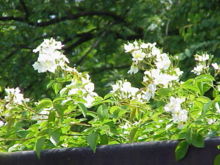Pink filipes
| Pink filipes | ||||||||||||
|---|---|---|---|---|---|---|---|---|---|---|---|---|

Pink filipes |
||||||||||||
| Systematics | ||||||||||||
|
||||||||||||
| Scientific name | ||||||||||||
| Pink filipes | ||||||||||||
| Rehder & EHWilson |
Pink filipes even Fadenstielige Rose called, is a plant of the genus roses ( Rosa ) within the family of the rose family (Rosaceae).
description
Appearance and leaf
Rosa filipes grows as a climbing shrub and reaches heights of 3 to 5 meters. There are long creeping branches. The stem-round branches have a bare, purple-brown bark and there are scattered, curved, up to 5 millimeters long, compact, flat spines that gradually expand to a broad base.
The alternate leaves are arranged in a petiole and a leaf blade and are 4 to 14 centimeters long. The petiole and the rhachis leaf have small hook- shaped spines and are sparsely hairy. The imparipinnate leaf blades usually have five or seven, rarely three or nine leaflets . With a length of 4 to 7 centimeters and a width of 1.5 to 3 centimeters, the leaflets are elongated or lanceolate, rarely obovate with a slightly rounded or broadly wedge-shaped base, a pointed upper end and usually simply serrated, rarely inconspicuous double sawn, edge; they are a little wrong sometimes. The underside of the leaf is almost bare or with fine, downy hair along the raised leaf veins and dotted with glands; the top of the leaf is bare. The narrow stipules are fused with the petiole for most of their length. The free area of the stipules is lanceolate, with entire margins with a pointed upper end and sparsely hairy, glandular and downy.
Inflorescence, flower and fruit
The flowering period in China extends from June to July. 25 to 35 flowers are in a compound umbrella-clustered or panicle inflorescence , which has a diameter of up to 15 centimeters, together. The bracts are ovate-lanceolate or lanceolate with a pointed upper end and a glandular-downy hairy edge. The 2 to 3 centimeter long peduncle is hairy sparsely glandular and downy.
The flowers can be slightly fragrant. The hermaphroditic flowers have a diameter of 2 to 2.5 centimeters and are radially symmetrical and five-fold with a double flower envelope . The glandular-downy hairy flower cup (hypanthium) is egg-shaped. The five sepals , which sometimes fall off early, are entire, ovate-lanceolate with a pointed upper end, sparsely downy and downy, hairy underside and dense downy, hairy top. The five free, white petals are obovate. There are many stamens present. The downy, hairy stylus are fused into a tube and tower above the petals.
In China, the rose hips ripen from June to November and turn red. With a diameter of about 8 millimeters, the rose hip is almost spherical and usually crowned by the sepals that are curved back.
Occurrence
Rosa filipes thrives in the thicket and along roadsides at altitudes of 1,300 to 2,300 meters in the Chinese provinces of Gansu , Shaanxi , Sichuan , Yunnan and in the Xizang autonomous region .
Systematics
The first description of Rosa filipes was in 1915 by the English botanist and plant collector Ernest Henry Wilson and the German-American botanist Alfred Rehder . The type material was collected in July and November 1908 in the thicket at altitudes of 1300 to 2300 meters near Wenquan Xian in the Chinese province of Sichuan and deposited with the collection number EH Wilson 1228.
In 2003, Gu Cuizhi of the Flora of China suspected that Rosa tatsienlouensis Cardot 1916 was identical to Rosa filipes ; further investigations are required.
use
The wild rose Rosa filipes is a rambler rose that grows up to 25 meters high on a suitable climbing frame or tree with its heavily reinforced, strong, long branches. It blooms profusely in large, drooping clusters with up to 100 fragrant, (cream) white flowers. In autumn the foliage turns rusty red and pea-sized rose hips appear in clusters . It tolerates partial shade and is conditionally frost hardy . Without a climbing frame, Rosa filipes can overgrow large areas as ground cover .
The cultivar 'Kiftsgate' was discovered in 1954 by E. Murell as a seedling in Kiftsgate Court in Gloucestershire .
swell
- Gu Cuizhi & Kenneth R. Robertson: Rosa : Rosa filipes , p. 376 - the same text online as the printed work , In: Wu Zheng-yi & Peter H. Raven (Eds.): Flora of China , Volume 9 - Pittosporaceae through Connaraceae , Science Press and Missouri Botanical Garden Press, Beijing and St. Louis, 2003. ISBN 1-930723-14-8 (Sections Occurrences and Systematics)
Individual evidence
- ↑ a b c d e Gu Cuizhi & Kenneth R. Robertson: Rosa : Rosa filipes , p. 376 - online with the same text as the printed work , In: Wu Zheng-yi & Peter H. Raven (eds.): Flora of China , Volume 9 - Pittosporaceae through Connaraceae , Science Press and Missouri Botanical Garden Press, Beijing and St. Louis, 2003. ISBN 1-930723-14-8
- ^ A b Rosa filipes in the Germplasm Resources Information Network (GRIN), USDA , ARS , National Genetic Resources Program. National Germplasm Resources Laboratory, Beltsville, Maryland. Retrieved September 7, 2014.
- ↑ First description scanned at biodiversitylibrary.org .
- ↑ Rosa filipes at Tropicos.org. Missouri Botanical Garden, St. Louis, accessed September 7, 2014.
literature
- Heinrich Schultheis: Roses: the best kinds and varieties for the garden , p. 58, Ulmer: Stuttgart 1996, ISBN 3-8001-6601-1
- Charles & Brigid Quest-Ritson: Roses: The Great Encyclopedia / The Royal Horticultural Society; Translation by Susanne Bonn; Editor: Agnes Pahler; S. 218, Dorling Kindersley, Starnberg 2004, ISBN 3-8310-0590-7
